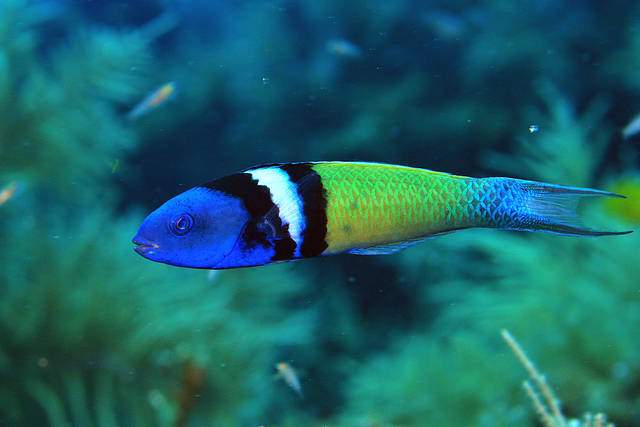
Thalassoma bifasciatum
FAMILY
Labridae
TAXONOMY
Thalassoma bifasciatum Bloch, 1791, East India (actually western
Atlantic).
OTHER COMMON NAMES
English: Bluehead wrasse, tiki tiki; Spanish: Cara de cotorra.
PHYSICAL CHARACTERISTICS
Length 9.9 in (25 cm). Begins life as yellow, eventually develops
black, horizontal stripes. Large terminal-phase males have
vivid blue heads followed by white and black vertical bands,
then green rear bodies and a bluish tail.
DISTRIBUTION
Western Atlantic Ocean near Bermuda, also from northern
South America to the West Indies and southern Florida,
United States, and into the Gulf of Mexico.
HABITAT
Coral reefs. Also seen among sea grass beds.
BEHAVIOR
Juveniles often provide cleaning services to other fishes.
Among adults, spawning occurs differently depending on the
size of the reef. On large reefs, group spawning is the rule. On
small reefs, terminal-phase males utilize mating territories.
Males from ensuing generations frequently use their ancestral
mating site, apparently as a result of social convention. Dozens
of females may select the same spawning site, and thus mate
with the same male. Groups of smaller males often mate with
egg-laden females by ambushing them on their way to the territorial
mating sites.
FEEDING ECOLOGY AND DIET
Primarily feeds on drifting zooplankton, but also takes crabs,
shrimps, sea urchins, and sea stars. Sometimes engage in cleaning
of other species.
REPRODUCTIVE BIOLOGY
Engage in sex reversal. Over a period of several weeks, the
black-striped, yellow males or females take on full coloration of
large, terminal-phase males. Initial-phase females can take on
the role of the terminal-phase male and begin producing sperm
in as few as eight days.
CONSERVATION STATUS
Not listed by the IUCN.
SIGNIFICANCE TO HUMANS
Aquarium fish.
Photo Gallery of - Bluehead





 Animalia Life
Animalia Life